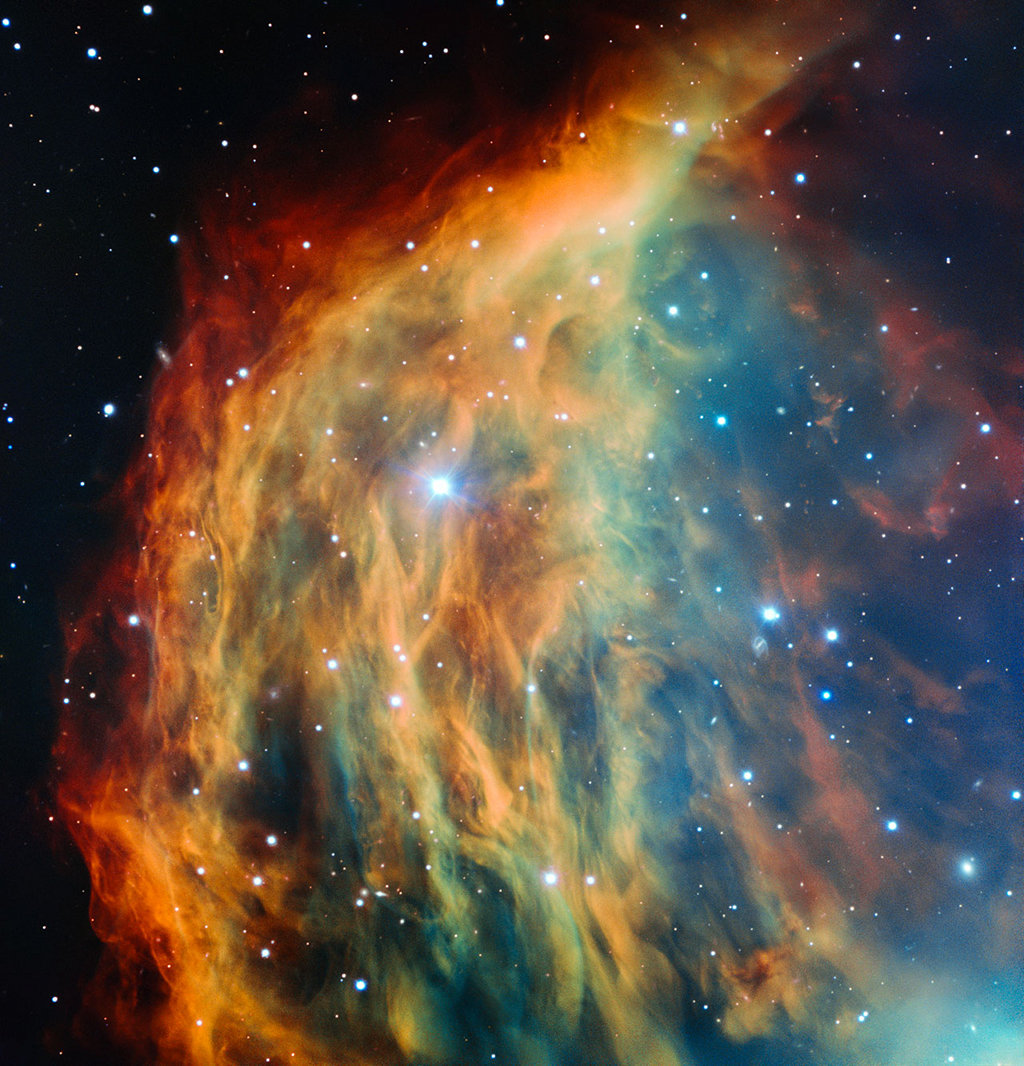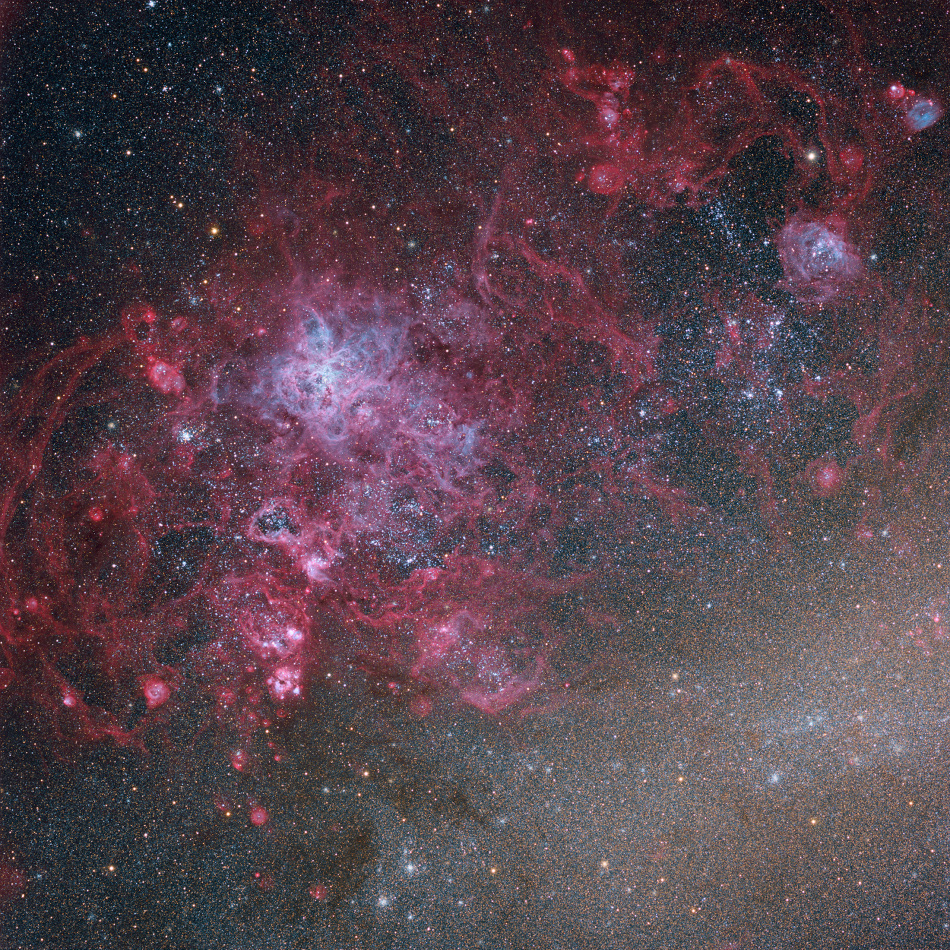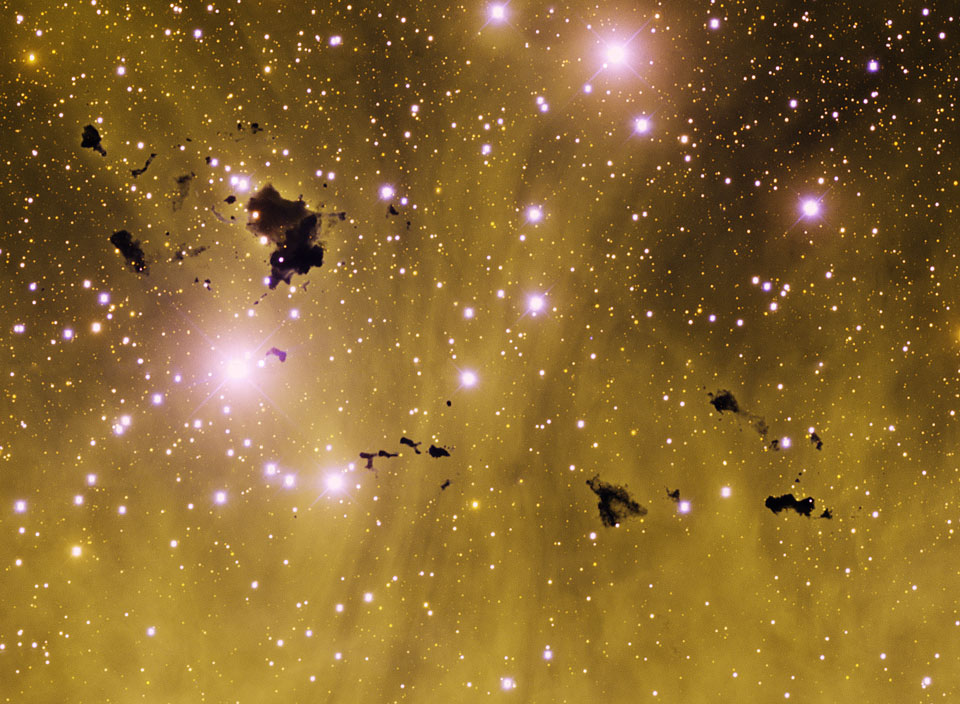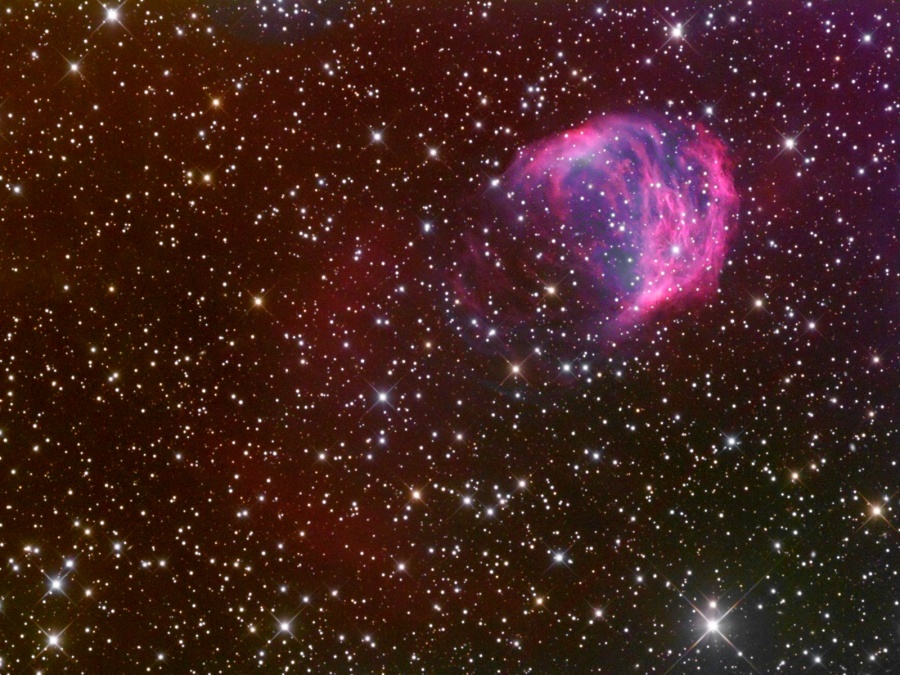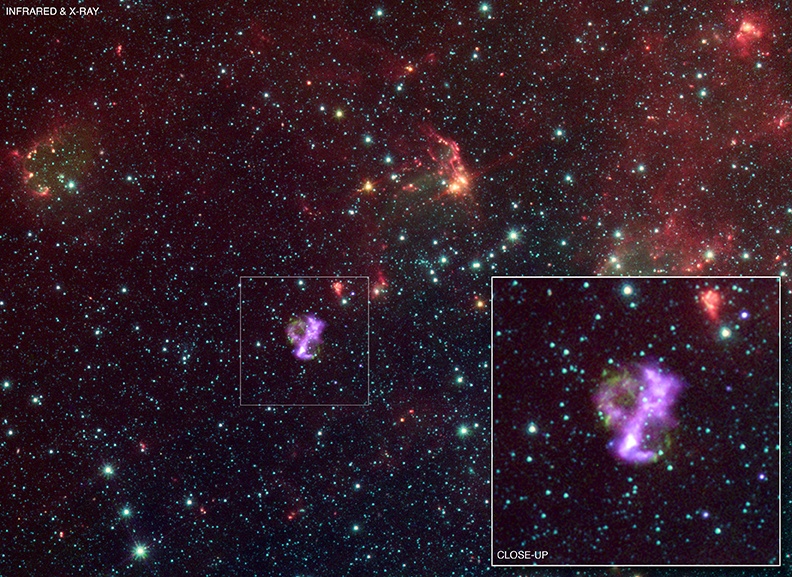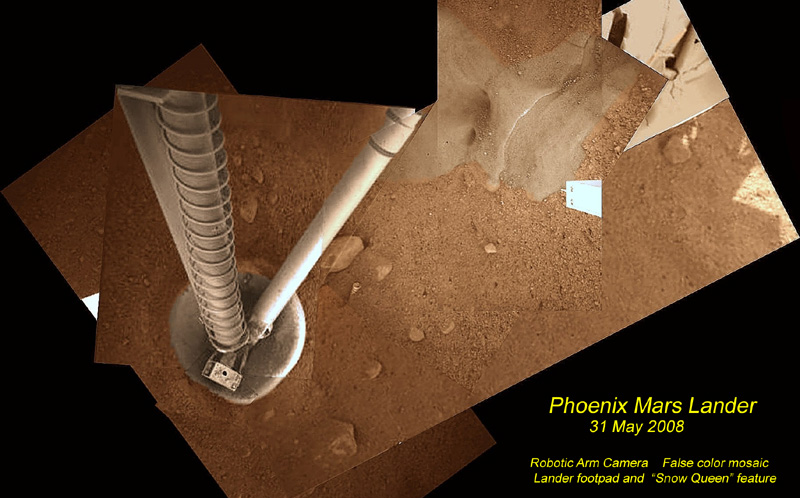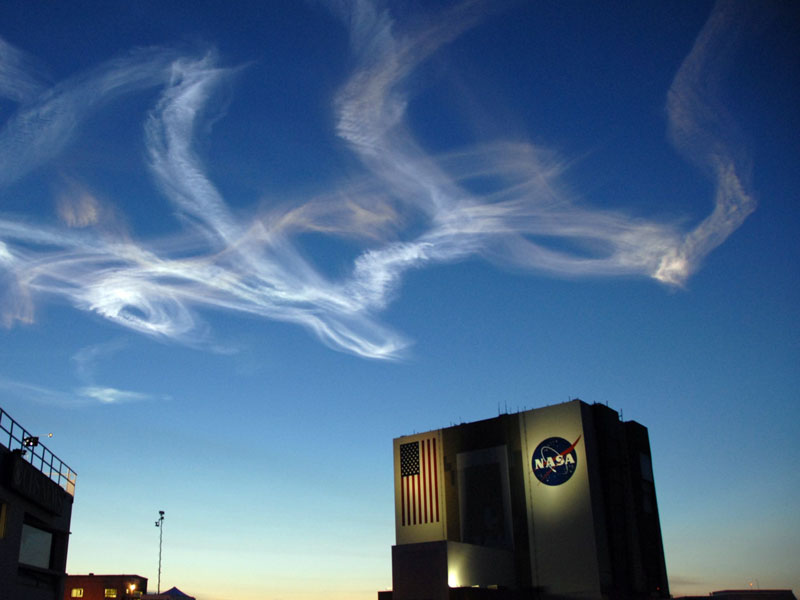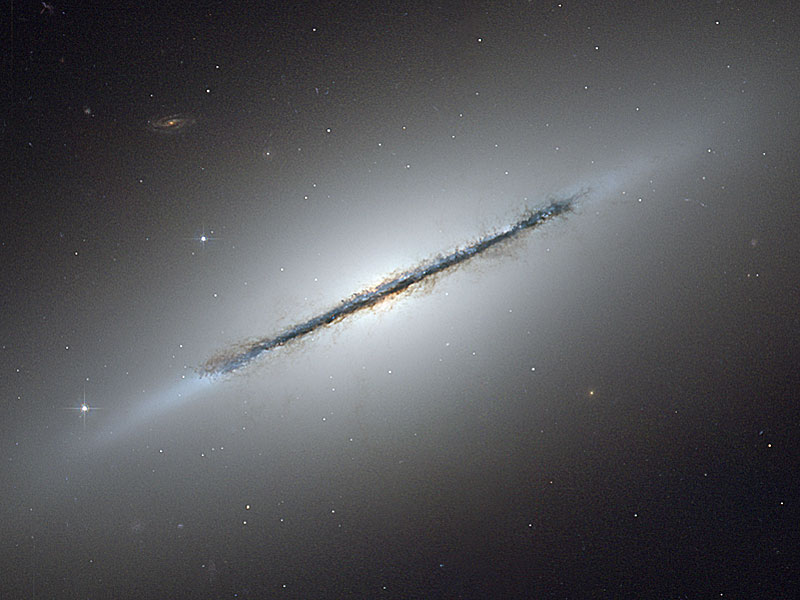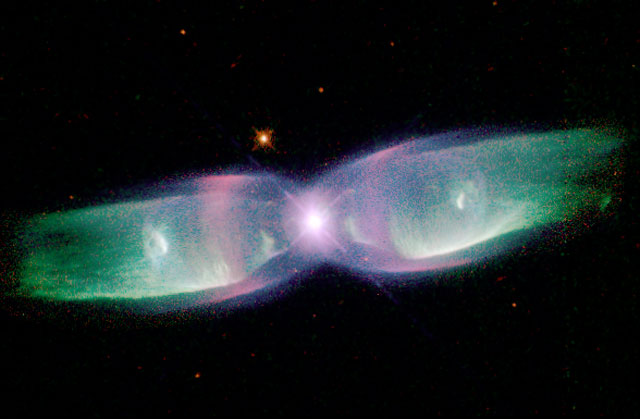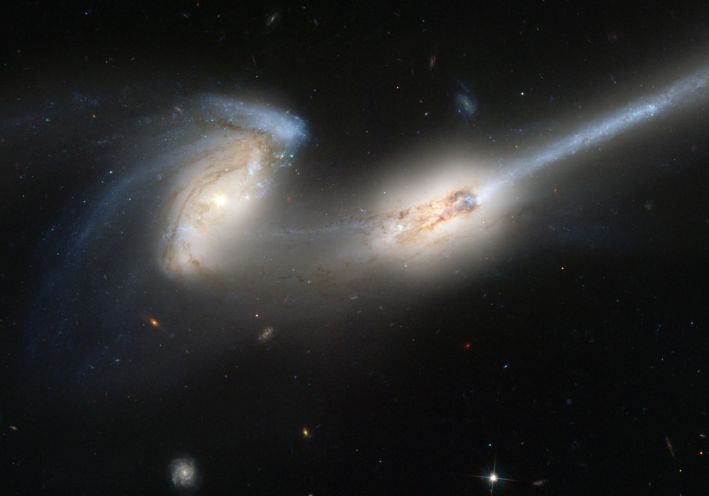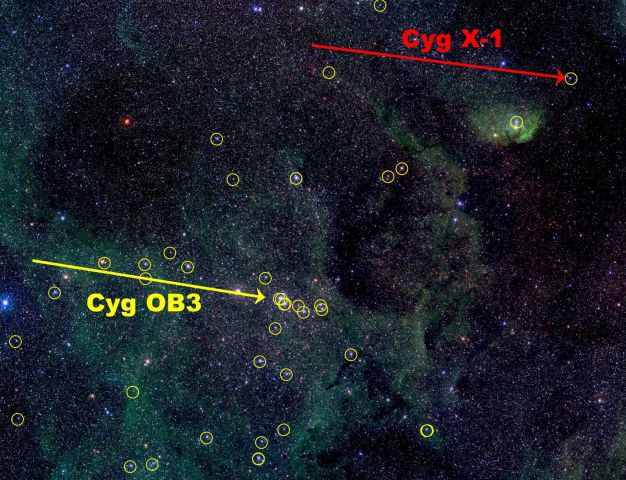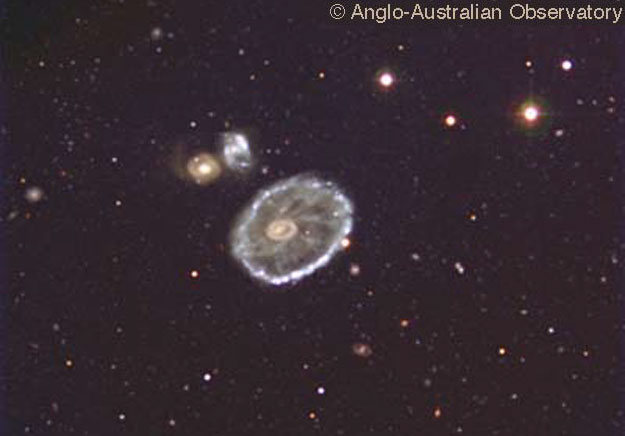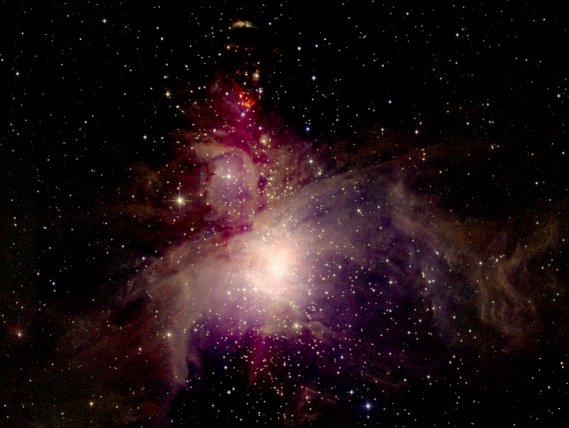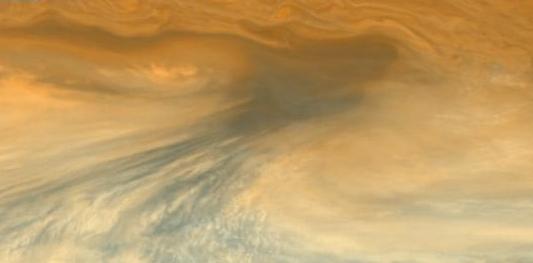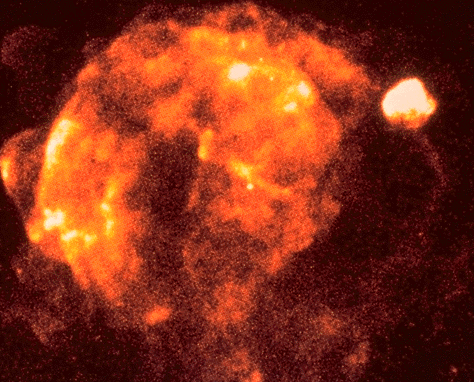| << Previous | Index | Next >> |
2015 Braided, serpentine filaments of glowing gas suggest this nebula's popular name, The Medusa Nebula. Also known as Abell 21, this Medusa is an old planetary nebula some 1,500 light-years away along the southern border of the constellation Gemini. Like its mythological namesake, the nebula is associated with a dramatic transformation. The planetary nebula phase represents a final stage in the evolution of low mass stars like the sun, as they transform themselves from red giants to hot white dwarf stars and in the process shrug off their outer layers. Ultraviolet radiation from the hot star powers the nebular glow. An unrelated, bright, foreground star is near center in this close-up, telescopic view, while the Medusa's transforming central star is actually the dimmer star below center and toward the right-hand part of the frame. The Medusa Nebula is estimated to be over 4 light-years across.
2014 The Tarantula Nebula is more than 1,000 light-years in diameter, a giant star forming region within our neighboring galaxy the Large Magellanic Cloud (LMC). That cosmic arachnid lies toward the upper left in this deep and colorful telescopic view made through broad-band and narrow-band filters. The image spans nearly 2 degrees (4 full moons) on the sky and covers a part of the LMC over 8,000 light-years across. Within the Tarantula (NGC 2070), intense radiation, stellar winds and supernova shocks from the central young cluster of massive stars, cataloged as R136, energize the nebular glow and shape the spidery filaments. Around the Tarantula are other violent star-forming regions with young star clusters, filaments, and bubble-shaped clouds In fact, the frame includes the site of the closest supernova in modern times, SN 1987A, just above center. The rich field of view is located in the southern constellation Dorado.
2013
Click to play embedded YouTube video.
Image Credit: NASA/Johns Hopkins University Applied Physics Laboratory/Carnegie Institution of Washington
2012 These are larger dust bunnies than you will find under your bed. Situated in rich star fields and glowing hydrogen gas, these opaque clouds of interstellar dust and gas are so large they might be able to form stars. Their home is known as IC 2944, a bright stellar nursery located about 5,900 light years away toward the constellation of Centaurus. The largest of these dark globules, first spotted by South African astronomer A. D. Thackeray in 1950, is likely two separate but overlapping clouds, each more than one light-year wide. Along with other data, the above representative color image from the 4-m Blanco telescope at Cerro Tololo, Chile indicates that Thackeray's globules are fractured and churning as a result of intense ultraviolet radiation from young, hot stars already energizing and heating the bright emission nebula. These and similar dark globules known to be associated with other star forming regions may ultimately be dissipated by their hostile environment -- like cosmic lumps of butter in a hot frying pan.
2011
2010 Braided, serpentine filaments of glowing gas suggest this nebula's popular name, The Medusa Nebula. Also known as Abell 21, this Medusa is an old planetary nebula some 1,500 light-years away in the constellation Gemini. Like its mythological namesake, the nebula is associated with a dramatic transformation. The planetary nebula phase represents a final stage in the evolution of low mass stars like the sun, as they transform themselves from red giants to hot white dwarf stars and in the process shrug off their outer layers. Ultraviolet radiation from the hot star powers the nebular glow. The Medusa's transforming star is near the center of the overall bright crescent shape. In this deep, wide telescopic view, fainter filaments clearly extend below and to the left of the bright crescent region. The Medusa Nebula is estimated to be over 4 light-years across.
2009 SNR 0104 is a supernova remnant with an unusual shape. Found 190,000 light-years away in our neighboring galaxy the Small Magellanic Cloud, SNR 0104 is suspected of being the expanding debris cloud from a Type 1a supernova - the catastrophic thermonuclear explosion of a white dwarf star. For example, like Type 1a supernova remnants within our galaxy, investigations show that it contains large amounts of iron. But unlike other Type 1a remnants, including the well-studied Tycho, Kepler, and SN 1006, SNR 0104 is definitely not spherical. In fact, the remnant's shape suggests this supernova explosion was very asymmetric and produced strong jets. This intriguing composite image combines Chandra Observatory x-ray data of the remnant, shown in purple hues, with Spitzer Space Telescope infrared data covering the wider region, mapped to red and green colors. It indicates that the supernova explosion took place in the complicated and dense environment of a star-forming region. So, an alternative explanation is that the expanding debris cloud is sweeping up clumpy interstellar material, accounting for the odd shape. The broad, multiwavelength view spans about 1,800 light-years at the estimated distance of SNR 0104.
2008
2007 What kind of cloud is that? Not a naturally occurring one. Pictured above is the drifting smoke plume left over from last Friday's launch of the Space Shuttle Atlantis. The twisted plume was captured shortly after launch high above NASA's massive Vehicle Assembly Building, the largest single story building in the world. Rockets frequently create picturesque plumes during launch. The Space Shuttle is currently visiting the International Space Station and delivering a new backbone truss segment to the continually developing and occupied spaceport. This trip, officially labeled STS-117, is the 118th space shuttle flight overall and the 28th for the Atlantis Orbiter.
2006 Why is this galaxy so thin? Many disk galaxies are actually just as thin as NGC 5866, pictured above, but are not seen edge-on from our vantage point. One galaxy that is situated edge-on is our own Milky Way Galaxy. Classified as a lenticular galaxy, NGC 5866 has numerous and complex dust lanes appearing dark and red, while many of the bright stars in the disk give it a more blue underlying hue. The blue disk of young stars can be seen extending past the dust in the extremely thin galactic plane, while the bulge in the disk center appears tinged more orange from the older and redder stars that likely exist there. Although similar in mass to our Milky Way Galaxy, light takes about 60,000 years to cross NGC 5866, about 30 percent less than light takes to cross our own Galaxy. In general, many disk galaxies are very thin because the gas that formed them collided with itself as it rotated about the gravitational center. Galaxy NGC 5866 lies about 44 million light years distant toward the constellation of the Dragon (Draco).
2005 Are stars better appreciated for their art after they die? Actually, stars usually create their most artistic displays as they die. In the case of low-mass stars like our Sun and M2-9 pictured above, the stars transform themselves from normal stars to white dwarfs by casting off their outer gaseous envelopes. The expended gas frequently forms an impressive display called a planetary nebula that fades gradually over thousand of years. M2-9, a butterfly planetary nebula 2100 light-years away shown in representative colors, has wings that tell a strange but incomplete tale. In the center, two stars orbit inside a gaseous disk 10 times the orbit of Pluto. The expelled envelope of the dying star breaks out from the disk creating the bipolar appearance. Much remains unknown about the physical processes that cause planetary nebulae.
2004 These two mighty galaxies are pulling each other apart. Known as "The Mice" because they have such long tails, each spiral galaxy has likely already passed through the other. They will probably collide again and again until they coalesce. The long tails are created by the relative difference between gravitational pulls on the near and far parts of each galaxy. Because the distances are so large, the cosmic interaction takes place in slow motion -- over hundreds of millions of years. NGC 4676 lies about 300 million light-years away toward the constellation of Coma Berenices and are likely members of the Coma Cluster of Galaxies. The above picture was taken with the Hubble Space Telescope's Advanced Camera for Surveys which is more sensitive and images a larger field than previous Hubble cameras. The camera's increased sensitivity has imaged, serendipitously, galaxies far in the distance scattered about the frame.
2003 The formation of a black hole from the collapsing core of a massive star is thought to be heralded by a spectacular supernova explosion. Such an extremely energetic collapse is also a leading explanation for the mysterious cosmic gamma-ray bursts. But researchers now suggest that the Milky Way's most famous black hole, Cygnus X-1, was born when a massive star collapsed -- without any supernova explosion at all. Their dynamical evidence is summarized in this color image of a gorgeous region in Cygnus, showing Cyg X-1 and a cluster of massive stars (yellow circles) known as Cygnus OB3. Arrows compare the measured direction and speed of Cyg X-1 and the average direction and speed of the massive stars of Cyg OB3. The similar motions indicate that Cyg X-1's progenitor star was itself a cluster member and that its path was not altered at all when it became a black hole. In contrast, if Cyg X-1 were born in a violent supernova it would have likely received a fierce kick, changing its course. If not a supernova, could the formation of the Cyg X-1 black hole have produced a dark gamma-ray burst in the Milky Way?
2002 Part of the Sun disappeared behind the Moon earlier this week. Previously, the waning Moon was best visible from all places on Earth during the early morning hours because it led the Sun. As the Moon orbited the Earth, however, the Sun caught up to it and passed it on the sky. Now the waxing Moon trails the Sun and is therefore best visible just after sunset. Each month, as viewed from the Earth, the Sun appears to lap the Moon and the cycle repeats. Sometimes when the Moon passes the Sun, it goes directly in front of part of it, causing a partial eclipse. Pictured above, a time lapse sequence shows the Moon passing the Sun on June 10 behind the Golden Gate Bridge in San Francisco, California, USA.
2001 By chance, a collision of two galaxies has created a surprisingly recognizable shape on a cosmic scale. The Cartwheel Galaxy is part of a group of galaxies about 500 million light years away in the constellation Sculptor. Two smaller galaxies in the group are visible on the left of the above photograph. The Cartwheel's rim is an immense ring-like structure 100,000 light years in diameter composed of newly formed, extremely bright, massive stars. When galaxies collide, they pass through each other -- their individual stars rarely come into contact. The galaxies' gravitational fields, however, may be greatly distorted by the collision. In fact, the ring-like shape is the result of the gravitational disruption caused by a small intruder galaxy passing through a large one, compressing the interstellar gas and dust, and causing a wave of star formation wave to move out from the impact point like a ripple across the surface of a pond. In this case, the large galaxy may have originally been a spiral, not unlike our own Milky Way Galaxy, transformed by the collision. Recent astronomical detective work has indicated what has become of the intruder.
2000 What's happening in the center of this galaxy? Close inspection of the center of NGC 4438, as visible in this recently released representative-color image by the Hubble Space Telescope, reveals an unusual bubble of hot gas, colored in red. Astronomers speculate that this strange bubble was created by a massive central black hole that resides there. As gas swirls around the black hole, gravity and friction pull it in and heat it up. Some of the hot gas then falls into the black hole, but not all - some gas gets so hot it shoots out the poles in fast jets. When these jets impact nearby material, they heat it up and cause the detected glow. Galaxy NGC 4438 resides about 50 million light years from Earth, and the pictured central bubble measures about 800 light-years across.
1999 Venus, the second closest planet to the Sun, is a popular way-point for spacecraft headed for the gas giant planets in the outer reaches of the solar system. Why visit Venus first? Using a " gravity assist " maneuver, spacecraft can swing by planets and gain energy during their brief encounter saving fuel for use at the end of their long interplanetary voyage. This colorized image of Venus was recorded by the Jupiter-bound Galileo spacecraft shortly after its gravity assist flyby of Venus in February of 1990. Galileo's glimpse of the veiled planet shows structure in swirling sulfuric acid clouds. The bright area is sunlight glinting off the upper cloud deck. The Saturn-bound Cassini spacecraft will complete its own second flyby of Venus on June 24th. Launched in October of 1997, Cassini should reach Saturn in July 2004.
1998 Few astronomical sights excite the imagination like the nearby stellar nursery known as the Orion Nebula. The Nebula's glowing gas surrounds hot young stars at the edge of an immense interstellar molecular cloud only 1,500 light-years away. This distinctively detailed image of the Orion Nebula was constructed using data from the 2 Micron All Sky Survey or 2MASS. Now underway with telescopes in the Northern and Southern Hemispheres of planet Earth, the 2MASS project will map the entire sky in infrared light. The wavelength of infrared light is longer than visible light but more easily penetrates obscuring dust clouds. 2MASS cameras are sensitve to near infrared wavelengths around 2 microns or about 0.00008 inches. Visible light has a wavelength of about 0.00002 inches. Survey observations in three infrared bands were translated to blue, green, and red colors to produce this composite image.
1997 Known for its spectacular images of Jupiter's moons, Io, Ganymede, Callisto, and Europa, the robot spacecraft Galileo has also aggressively explored the Jovian atmosphere. In December of 1995, Galileo's atmospheric probe descended into Jupiter's clouds and reported a surprising absence of water. It is now believed that the probe entered through one of Jupiter's dry spots, similar to the dark region in this image of the swirling Jovian cloud deck. The smallest features visible here are tens of miles in size. These dry regions appear to correspond to locations where winds converge creating downdrafts. The downdrafts generate local cloudless clearings through which Jupiter's deeper warmer layers can be glimpsed. Just as the dark areas are extremely dry, the surroundings are full of moisture. The contrast is analogous to the desert and tropics of Earth.
1996 What happens when a star explodes? A huge fireball of hot gas shoots out in all directions. When this gas slams into the existing interstellar medium, it heats up so much it glows in X-rays. The above picture by the ROSAT satellite has captured some of these X-rays and shown -- for the first time -- the Vela supernova explosion was roughly spherical. Non-uniformity of the interstellar medium causes Vela's appearance to be irregular. The size of this X-ray emitting spherical shell is immense - 230 light years across, covering over 100 times the sky-area of the full Moon. The supernova that created this nebula occurred about 1500 light years away and about 11,000 years ago. Coincidently, a completely different supernova shell can also be seen in X-rays in this picture! It is visible as the bright patch near the upper right. This Puppis supernova remnant nebula is actually about four times farther than the Vela nebula.
| << Previous | Index | Next >> |
